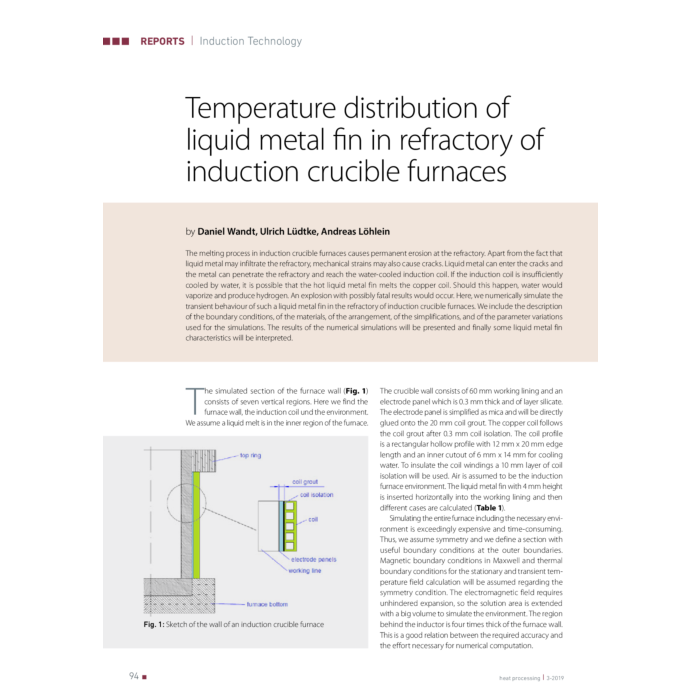Temperature distribution of liquid metal fin in refractory of induction crucible furnaces
€4.90
In stock
article number
00541_2019_03_06
The melting process in induction crucible furnaces causes permanent erosion at the refractory. Apart from the fact that liquid metal may infiltrate the refractory, mechanical strains may also cause cracks. Liquid metal can enter the cracks and the metal can penetrate the refractory and reach the water-cooled induction coil. If the induction coil is insufficiently cooled by water, it is possible that the hot liquid metal fin melts the copper coil. Should this happen, water would vaporize and produce hydrogen. An explosion with possibly fatal results would occur. Here, we numerically simulate the transient behaviour of such a liquid metal fin in the refractory of induction crucible furnaces. We include the description of the boundary conditions, of the materials, of the arrangement, of the simplifications, and of the parameter variations used for the simulations. The results of the numerical simulations will be presented and finally some liquid metal fin characteristics will be interpreted
| Authors | Daniel Wandt, Ulrich Lüdtke, Andreas Löhlein |
|---|---|
| Publishing Date | 25 Aug 2019 |
| Format | |
| Publisher | Vulkan-Verlag GmbH |
| Language | English |
| Title | Temperature distribution of liquid metal fin in refractory of induction crucible furnaces |
| Description | The melting process in induction crucible furnaces causes permanent erosion at the refractory. Apart from the fact that liquid metal may infiltrate the refractory, mechanical strains may also cause cracks. Liquid metal can enter the cracks and the metal can penetrate the refractory and reach the water-cooled induction coil. If the induction coil is insufficiently cooled by water, it is possible that the hot liquid metal fin melts the copper coil. Should this happen, water would vaporize and produce hydrogen. An explosion with possibly fatal results would occur. Here, we numerically simulate the transient behaviour of such a liquid metal fin in the refractory of induction crucible furnaces. We include the description of the boundary conditions, of the materials, of the arrangement, of the simplifications, and of the parameter variations used for the simulations. The results of the numerical simulations will be presented and finally some liquid metal fin characteristics will be interpreted |
Write Your Own Review

